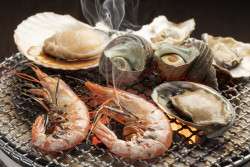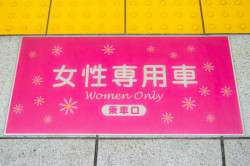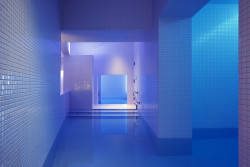
November 28, 2013
Marky Star
The history blogger reveals his obsession with hidden Tokyo
By Metropolis
Originally published on metropolis.co.jp on November 2013

While there has been a surprising “history boom” among young Japanese in recent years, this hasn’t necessarily spread to foreign residents of the country. One exception is Marky Star, author of the blog Japan This! (http://markystar.wordpress.com/), which started as a personal project and has developed into a valuable resource for history buffs around the world.
Why did you decide to start up “Japan This!”?
There were basically two different reasons–one for starting it and one for continuing it. The first was that when I’d make references to Japanese holidays on Facebook or in e-mails to my friends and family living outside of Japan I found myself re-explaining them again and again to each person. Instead of just repeating myself again and again, I thought it would be a good idea to just write a few articles like “Japanese New Year” or “Coming of Age Day” and keep them all in one place where I could just refer people. That was back in 2008, I think. Then I ran out of topics and just got bored with the whole thing. On New Year’s Day 2013, I decided to resurrect the blog and write one article a week. I kept the focus simple, writing about general things again, like “Japanese Manners.” I even took my first foray into history by writing an article about “The History of Japanese Toilets.” As I soon ran out of topics, I decided that I’d fill in the gaps with the etymology of Tokyo place names, which now makes up the bulk of the site’s content.
The reason I continue the blog is that for the past 9 years I’ve been obsessed with Japanese history. I also have a background in historical linguistics. In my free time, I’d research historical topics or linguistic topics. Since most of the information I was looking for was only available in Japanese, it seemed a shame to just keep all the cool stuff I was finding locked in my head. I wanted to make a place where I could have a permanent record of the stuff in English and share it with anyone else who had the same questions. I figured there might be one or two people out there who would be curious.
But the blog has evolved. I cringe when I look at some of the early posts. But I’m really curious what it will look like this time next year. Maybe I’ll feel the same way about my recent posts!
You address such seldom asked questions as “What does Setagaya mean?” What drives you to explore such obscure topics?
I think these are very natural questions to ask. I mean, if you look at the kanji for any given place name you’re bombarded with a frothy mixture of meaning and imagery and history. When I first came to Japan, I’d look at a simple place name like 谷中 Yanaka (valley in the middle) or 東京 Tokyo (eastern capital) and think “wow, how simple and descriptive” and then I’d see another place name like 渋谷 Shibuya (literally “bitter valley”) and think “WTF is that?” I know I’m not the only person—foreign or Japanese—to have experienced this. The internet is littered with articles on the topic in Japanese, but there doesn’t seem to be anyone else writing about it in English.
Which brings me to what has become my main motivation now. Namely, I’m frustrated that there isn’t any good information in English on certain topics of Japanese history—and if there is, it’s often not very good or just plain wrong. I just want to find out the truth —or as close as we can get to the truth—and share it with whomever is interested.
You have several posts on execution grounds around town that still have some remnants in tact. What interests you about the darker side of Japan’s history?
I get asked this a lot. But if people don’t know about Japanese history, the image of “Old Japan” is cherry blossoms, geisha and a reverent people in harmony with nature dressed in beautiful kimono practicing calligraphy and tea ceremony. But the truth is the bulk of Japanese history was spent in violent power grabs and brutal wars. Even when you get to the Edo Period (which is viewed as 250 some odd years of peace and tranquility) it was actually a kind of military dictatorship with a rigid class system. Seppuku (ritual disembowelment) may not have been a daily occurrence, but it was a very real thing to people of that time. Executions were public, or at least displayed. Torture and mutilation were normal punishments for certain crimes. Even the geisha and tea house girls who are so glamorized today weren’t there by choice. They were basically sold into sexual slavery by lower class families who couldn’t afford to feed them and saw “unnecessary” girls as a burden on the family. If you want to understand Japanese history, you can’t just whitewash it with sakura and wabi sabi, you have to look at the whole picture, even the dark side.
Your posts are obviously very thoroughly researched, but the tone can veer toward the irreverent. That makes it fun to read, of course, but do you ever get any complaints about that?
I’ve never gotten a single complaint. The closest it’s ever come have been readers pointing that I had called Kiyokawa Hachiro a douchebag something like 8 times in a single article and that comparing Ota Dokan’s literal annihilation of the Toshima Clan to rough oral sex might have been a little over the top. But other than that, I want history to be fun. Also, as a linguist I really believe there is no such thing as a “bad word.” My philosophy is “It’s my blog and if you don’t like it, then eff off.”
What is the most surprising thing you have uncovered while doing research for “Japan This?”
That other people actually want to read it! That’s crazy to me.
As I said, I think it’s natural to wonder about the origin of a place name or might want to know what a toilet in the Edo Period looked like. But I always feel like it’s a really nerdy project, but I get subscribers to my Twitter feed, and to my Facebook group every day. That’s just awesome to me. That means that even if these people just have a passing interest in Japanese history, they want to know more. I love Japanese history and I want other people see how cool and exciting it is too.
What sites are topics are on your “to do” list?
To be honest, I have no plan. If I see an interesting place name, I’ll get curious and start researching it. Some place names are related to other place names too. A great example of this are the place names Nerima, Toshima, Shakujii, Shibuya, and Kasai. If I cover one place, it just makes sense to cover the others. But each article is taken as a unique piece. Often I don’t know about the connections until I’ve finished writing the first article. Also a lot of my topics are requests that I get from readers.
Other than your excellent blog, what resources do you recommend for folks who want to get into Japanese history?
Well, I have 3 articles recommending books and podcasts on Japanese history (1, 2, 3). Some are in English and some are in Japanese. But whenever asked this question I always recommend Samurai Archives. The guys who run the site are awesome and they’ve been pushing pure, uncut, high grade Japanese history since the ’90s. Also, Jcastle.info is another invaluable resource on Japanese castles. Since Tokyo grew up as a castle town, the more you know about castles, the better you can understand the city. There’s a quirky, but cute, website called Edo Matsu that is a lot of fun to learn about life in Edo—it’s old and hasn’t been updated in ages and some links may be broken, but it’s worth a look. Old Tokyo is fun site if you’d like to see photo postcards of Japan during its transition from samurai rule to a modern, industrial state. And while I’m on the topic of photography, I’d be amiss if I didn’t mention my friend’s photostream, Rekishi no Tabi. He travels around Japan a lot and has loads of fantastic photos of historical buildings and cool Japanese stuff.







